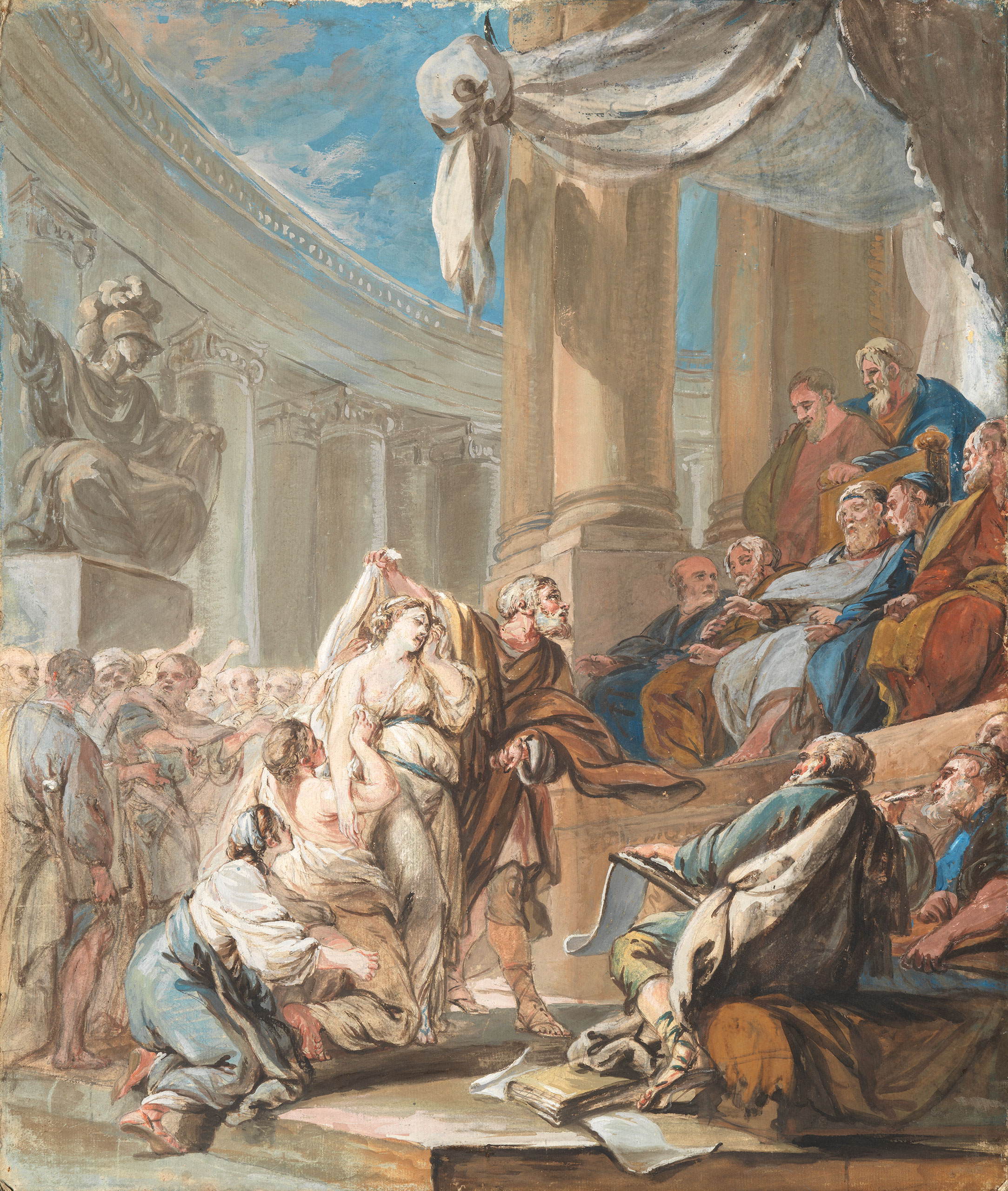
Baudouin
Pierre-Antoine
Paris 1723 – 1769
Phryne accuse of Impiety before the Areopagus of Athens
Graphite and goauche on paper laid down on board. In its original frame. Inscribed by an 18th-century or early-19th-century hand on the board backing Jugement inique rendu à Babylone contre Suzanne fille d’Hélias l’an 607 av. j.c.
53,2 x 45 cm (20 15/16 x 17 3/4 in.)
Provenance
Vente De Baecque, Paris, 20 November 2015, p. 9, lot 20 ; Private collection.
Bibliographie
Nathalie Lemoine-Bouchard, Les peintres en miniature actifs en France, 1650-1850, Les éditions de l’Amateur, 2008, p.76-77, cité p. 77, illustrated p. 25 in Introduction (p. 1-37).
Accepted into the Académie Royale de Peinture et de Sculpture on November 26, 1761, Baudouin exhibited miniature portraits and historical subjects at the Salon that same year. His ambition was to treat miniatures as history paintings, and the reception piece he presented to the Académie in August 1763, Phryne before Aeropagus,1 is a work in gouache on paper mounted on ivory plates, very similar in composition, color and technique to the one we present here, albeit slightly smaller in size.
On the reverse of our work is an ancient inscription suggesting the drawing would represent judgment of Susanna. Perhaps it was the presence of two elderly, bearded men, one undressing the accused, the other writing, that led the author of the inscription to recognize this biblical subject. However, there are several reasons why it cannot be this Old Testament episode, the most important of which are the statue of Athena, which places the scene in the ancient city and at the heart of its court, and the absence of Daniel, the young, wise judge who exonerates Susanna. Another reason could be the young woman’s attitude: unlike Suzanne, whose modesty is at stake, she doesn’t think of covering her bare breast. So, here too, the drawing depicts Phryné de Thespias, an ancient Greek courtesan of the 4th century B.C., and the model for sculptor Praxiteles’ sculptures of Aphrodite. According to Athenaeus of Naucratis,2 Phryne was accused of murder by one of her former lovers, Euthias. We also read that she was accused of introducing a foreign divinity into Athens, a crime that carried the death penalty,3 as happened to Socrates. Her lawyer, the orator Hyperides, running out of arguments and feeling his cause was lost, “tore her tunic and revealed her breasts to everyone”, a traditional gesture of supplication in ancient Greece, later misinterpreted as a gesture of seduction. The judges, moved by pity and religious fear, acquitted her.
The scene depicted here corresponds to the text: Phryne is in Athens before a tribunal which, since 1763, the title of the work in the Louvre refers to as the Areopagus, but which is in fact the Heliæum (a popular tribunal held during the day, unlike the previous one, which was held at night); the man pleading is indeed Hyperides, and his gesture of exposing the accused’s breast leaves no ambiguity on the subject. In the reception piece preserved in the Louvre, executed with much greater care and smoothness, the two old men have been replaced by young men, probably to avoid any confusion with Suzanne’s story.
The sketchy execution and the schematic, slightly squared-off characterization of the people in the courtroom and the crowd may suggest the hand of Jean-Baptiste Deshays rather than Baudouin. Baudouin was certainly inspired by his father-in-law François Boucher – Diderot says as much about the reception piece, suspecting that Boucher helped him4 – and no doubt by his then-successful brother-in-law, considered the budding reformer of French painting. In the 1760s, Deshays also executed and signed a large drawing of the same subject, typical of the artist in its squared-off figures with bar-like eyes, whose horizontal composition further accentuates the work’s compactness. This drawing, no. 12 in the Deshays sale5 and subsequently owned by Randon de Boisset6 and Vassal de St Hubert7, is now in the Metropolitan Museum (Rogers Fund, 1961, Inv. 61.126). The shapes are even more square and schematic than in our work. In the latter, the eyes forming blotches are not typical of Deshays’ manner, who draws lines in place of the eyes. Our drawing does not feature Deshays’ typical way of drawing hands in small, wide strokes. The faces of the main characters, on the other hand, are typical of Baudouin.
A drawing by Baudouin, formerly in the Baderou collection, sold to Colnaghi and now at the Ashmolean Museum, is an intermediate step between the work we are presenting and the reception piece. Many of its details are similar to ours: the upper body of Phriné, who brings her left hand to her face and intertwines her right arm with that of the kneeling servant; the presence of an elderly, bearded man writing in the lower right; the presence of standing figures behind the seated judges; the absence of figures in the background between the main group and the judges. These details are not found in the work in the Louvre. On the other hand, the Ashmolean drawing already contains Phriné’s kneeling position, the presence of the maid standing behind the accused, the age and position of the man stripping her naked, the standing position of the Athena sculpture and the circular shape of the pedestal decorated with reliefs and the two steps which are visible in the reception piece.
The drawing thus links the two works, showing that they unquestionably belong to the same artist, Baudouin. In addition, the older, bearded man writing in the lower right-hand corner of our drawing is replaced in the Louvre drawing by a younger man. The old man is maintained and simply moved to the far right of the composition, replacing another old man, dressed in blue: only his torso is visible in profile, but he is dressed in the same colors, with a green coat, draped in a gray tint of parma, and makes a similar backward movement.
It remains plausible that the two artists discussed this project or studied it together. Did Deshays’ composition come about during these discussions, in order to advise his brother-in-law? In order to treat such a rare and refined subject from classic history, Baudouin has probably been inspired by Deshays, who was held in such high esteem at the time. He may also have studied Deshays’ Marriage of the Virgin (Douai, collegiale de Saint-Pierre), painted the same year, which displays the same upward dynamic from left to right, with obliques built up by the arrangement of the figures. The group of two deacons in the lower right of the Douai work is also very reminiscent of the group of two figures used by Baudouin in the same place in our drawing as in his reception piece.
It therefore seems logical to consider our drawing as a full-size presentation work in the final medium for the reception piece, a first study that was later largely modified because it was probably not in keeping with the text and a source of confusion in the reading of the subject. The reception piece falls into the category of miniatures, so it is meticulously executed and far more meticulous than the sketch we present here: its architectures are worked with lines drawn with a ruler; the artist seeks to obtain a polished material, as if he were working on ivory, whereas he is using paper pasted on ivory; he treats with great application the details of the ornamental friezes on the architecture, the hairstyles of the maidservants, the clothes of the man writing in the lower right-hand corner, etc. In our work, a presentation drawing, all this is merely suggested, since it is above all the strength of the composition and the coherence of color and form that are put to the test. This spectacular work is therefore an important addition to Baudouin’s body of graphic works.
-
Paris, Louvre Museum, Inv. 23700, 464 x 382 mm.
-
Athenaeus of Naucratis, Deipnosophistae (XIII, 59), circa 228 AD.
-
Plutarch in his Moralia (chapter 20) indeed writes about a trial for impiety.
-
Salon 1763 : « Monsieur Boucher, you won’t recognize it but from time to time you have snatched the paintbrush from you poor son-in-law’s hands. »
-
Catalogue de dessins et de tableaux après le décès de M. Deshays, peintre du Roi par Pierre Remy, 26 March 1765, lot 12 : « Phryne, an Athenian courtesan, accused of impiety and defended by the orator Hyperides. This capital design, done in pen and bistre with white highlights, is composed of more than twenty figures in the style of the greatest masters.»
-
Catalogue de tableaux & desseins précieux des maîtres célèbres des trois écoles, figures de marbres, de bronze & de terre cuite, estampes en feuilles & autres objets du cabinet de feu M. Randon de Boisset, Receveur général des Finances, par P. Remy […], 27 February 1777 : Jean-Baptiste Henri Deshays : lot 372 : « Phryne before the Areopagus, subject taken from Greek history. Purchased by Desmarest. »
-
Catalogue d’une riche collection de dessins et estampes des plus grands maîtres des trois écoles montés sous verre & en feuilles ; pastels & miniatures de Rosalba, & d’autres bons Maîtres ; de très belles gouaches, &c. qui composent le cabinet de M. *** par Pierre Remy, 29 mars 1779, lot 150 : Jean Baptiste Deshays : « Phryne before the Areopagus, a subject taken from Greek history, this good drawing is washed in bistre and enhanced with white. It measures 10 pouces 9 lignes hight by 22 pouces wide ». According to the Getty Provenance Index Databases, this is the collection of Jean-Antoine-Hubert Vassal de Saint-Hubert (1741-1782), fermier général and valet de chambre to the Comte de Provence. The ancient dimensions correspond to those of the drawing: 47,5 x 60,2.

